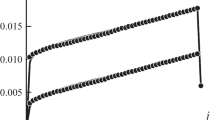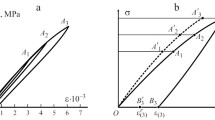The behavior of organic- and carbon-fiber-reinforced plastics based on three different binders was investigated under three test modes: stress relaxation, strain relaxation, and creep. In the theory used, the linearized generalized Maxwell–Gurevitch equation is employed. From stress relaxation diagrams, the relaxation constants of the equation are determined, which are utilized for calculating creep diagrams. The elastic and strength characteristics of the composites are also investigated.





Similar content being viewed by others
Notes
ECD is a polyglycidyl derivative of the aromatic amine 3,3´-dichlor-4,4´-diaminodiphenylmethane, containing 27-30% epoxy groups, 5-6% nitrogen, and 12-15% chlorine, cured by isomethyltetrahydrophthalic anhydride (MTHPA) or diaminodiphenylsulfone (DADPS) [3]. Rolivsan MV-1 is a liquid monomer-oligomer composition obtained in a chemical way.
References
G. Lubin (ed.), Handbook of Fiberglass and Advanced Plastics Composites, New York (1969).
Yu. M. Tarnopol’skii and T. Ya. Kintsis, Methods of Static Tests on Reinforced Plastics [in Russian], Khimiya, Moscow (1975).
B. A. Zaitsev, G. I. Khramova, T. A. Tsygankova, R. F. Kiseleva, L. A. Laius, M. I. Besonov, M. F. Lebedeva, and S. K. Zakharov, “Rolivsans — new binders for heat-resistant and strong reinforced plastics,” Mech. Compos. Mater., No. 5, 512–515 (1982).
G. I. Gurevich, Deformation of Media and the Distribution of Seismic Waves [in Russian], Nauka, Moscow (1974).
A. L. Rabinovich, Introduction into the Mechanics of Reinforced Polymers [in Russian], Nauka, Moscow (1970).
A. S. Freydin and R. A. Turusov, Properties and Calculation of Adhesive Joints [in Russian], Khimiya, Moscow (1990).
R. A. Turusov, A. J. Gorenberg, and B. M. Yazyev, “Long-term strength of adhesive joints at a normal separation,”Klei. Germetiki. Tekhnologii, No. 7, 14-25 (2011).
S. S. Stoychev, R. A. Turusov, L. M. Hadjikov, et al., “Passive visco-elastic mechanical properties of small human intestine. Comparative study with other soft tissues,” J. Theor. Appl. Mech., 36, No. 4, 55–70 (2006).
Author information
Authors and Affiliations
Corresponding author
Additional information
Translated from Mekhanika Kompozitnykh Materialov, Vol. 48, No. 3, pp. 449-458 , May-June, 2012
Rights and permissions
About this article
Cite this article
Kuperman, A.M., Turusov, R.A. Relaxation characteristics of reinforced plastics in tension of ring specimens by split disks. Mech Compos Mater 48, 305–312 (2012). https://doi.org/10.1007/s11029-012-9277-3
Received:
Revised:
Published:
Issue Date:
DOI: https://doi.org/10.1007/s11029-012-9277-3




